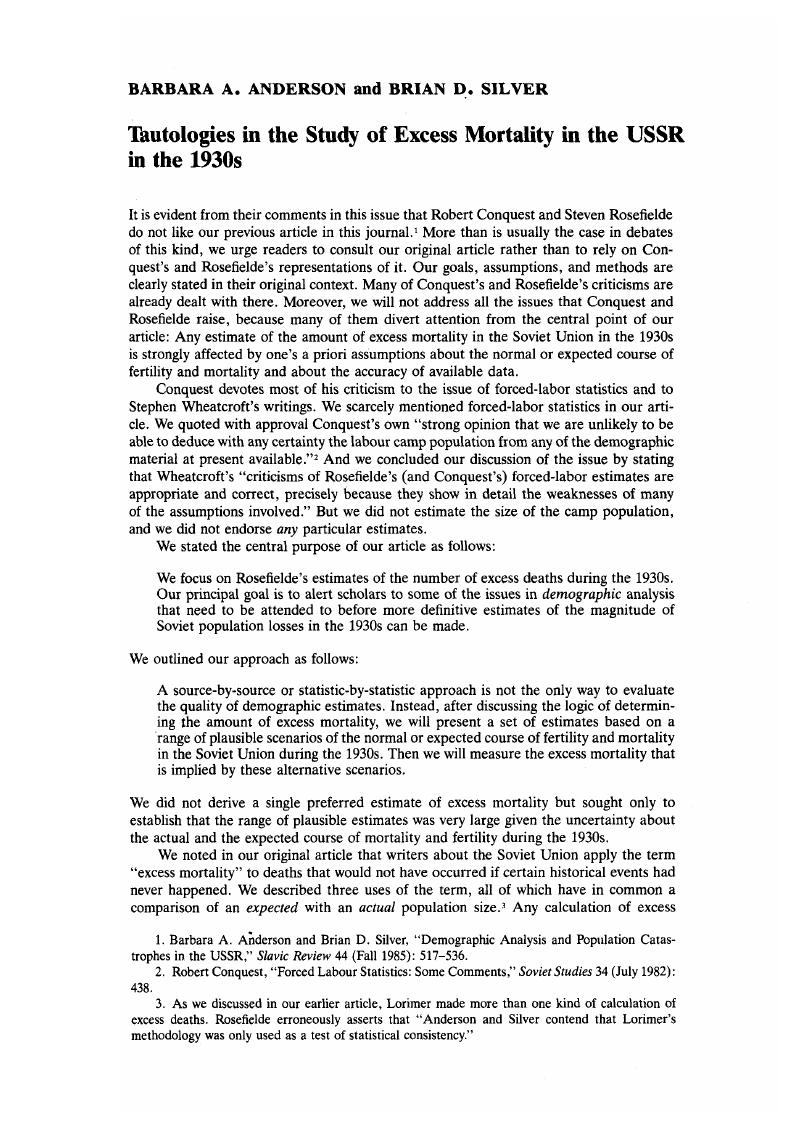Published online by Cambridge University Press: 27 January 2017

1. Anderson, Barbara A. and Silver, Brian D., “Demographic Analysis and Population Catastrophesin the USSR,” Slavic Review 44 (Fall 1985): 517–536.CrossRefGoogle Scholar
2. Robert, Conquest, “Forced Labour Statistics: Some Comments,” Soviet Studies 34 (July 1982): 438.Google Scholar
3. As we discussed in our earlier article, Lorimer made more than one kind of calculation ofexcess deaths. Rosefielde erroneously asserts that “Anderson and Silver contend that Lorimer's methodology was only used as a test of statistical consistency. “
4. There are many possible counterfactual scenarios. We have presented a range that wouldencompass most of the likely ones. One must bear in mind that even if there were no forced collectivization, famine, or Terror, a rapid industrialization program would have had serious demographic effects. In particular, fertility was likely to be reduced because of separation of families, postponedmarriage, and displacement of population. Scenarios that do not assume rapid industrialization and collectivization could also be entertained—but what the course of mortality and fertility would havebeen under such a regime can only be a matter of speculation.
5. One way to derive a larger estimate of excess deaths than that produced under the range of assumptions we used in our estimates is to assume that the mortality rates in the USSR in the 1930s were much better than those reported in 1938 and 1939. To obtain an estimate of excess deaths between 1926 and 1939 to those alive in 1926 of the magnitude Rosefielde suggests, one would haveto assume an expectation of life at birth of about seventy years.
6. For further discussion of the distinction between a population deficit and excess deaths, see our original article.
7. We noted in our article that none of the Soviet censuses has been thoroughly evaluated andthat certain kinds of systematic error, such as underenumeration of young children, have been identified in several of them. Neither the 1926 nor the 1939 census should be regarded as a completely accurate count. But few censuses can be categorically regarded as good or bad for all purposes.
8. This construction is based on the argument in Steven, Rosefielde, “Excess Mortality in theSoviet Union: A Reconsideration of the Demographic Consequences of Forced Industrialization, 1929–1949,” Soviet Studies 35 (July 1983): 385–409.Google Scholar
9. Ibid., tables 3 and 6.
10. Rosenelde could resolve his doubts if he carefully examined the sources he cited to discredit Lorimer's evaluation.
11. Rosenelde erroneously states that we accused him of misrepresenting Urlanis's estimates as real. In fact, we criticized Rosenelde for using Urlanis's estimates because those estimates are not plausible.
12. Contrary to Rosefielde's contention, Sifman's study of fertility histories of Soviet womendoes not support his assumptions about fertility rates for the 1930s. (See Sifman, Roza I., Dinamika rozhdaemosti v SSSR (Po materialam vyborochnykh obsledovanii [Moscow: Statistika, 1974].Google Scholar) First, Sifman's grouping of fertility data into five-year periods makes it impossible to identify year-to-yearfertility trends in the early 1930s, for example, how much fertility declined in 1933–1934 as a resultof the 1932–1933 famine. Second, relying on interviews of women who survived to the 1960s toconstruct precise fertility rates for all Soviet women in 1930s is extremely problematic. Third, muchof Sifman's data was derived as part of the family budget surveys conducted by the Central Statistical Board, and the samples in these surveys are not representative of the Soviet population as a whole. (On the last point, see Stephen, Shenfield, “A Note on Data Quality in the Soviet Family BudgetSurvey,” Soviet Studies 35 [October 1983]: 561–568 Google Scholar.) Even data with these limitations can be of some use in the study of cohort differences in fertility, but they are not adequate substitutes for vital registration data from the periods of interest.
13. Murray Feshbach, “The Soviet Union: Population Trends and Dilemmas,” Population Bulletin 37 (August 1982).
14. Ibid., p. 7.
15. Rosefielde confuses the concepts of excess mortality and population deficit in his analysisof population losses between 1937 and 1959. Even though he asserts that the unaccounted-for discrepancyin population in this period represents excess deaths, this discrepancy is a residual categorythat reflects not only excess deaths, but also all other sources of error in his assumptions and measuresof fertility, mortality, and migration.